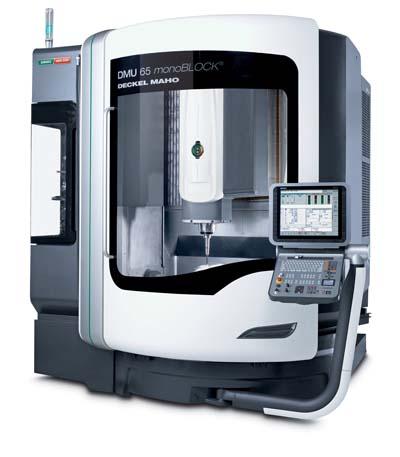
The new generation of the DMG/Mori Seiki's monoBLOCK series has become a sales hit since its introduction in 2010. The most recent version of the first model of this series, the DMU 65 monoBLOCK NEXT GENERATION, also impresses with its dynamics and efficiency. The universal milling machine has a significantly narrower rotating bridge, an innovation which comes into its own particularly when manufacturing small components for medical or tool engineering.
The DMU 65 monoBLOCK NEXT GENERATION can master all disciplines of milling technology, from rough machining to finish machining. The FEM-optimised machine concept with weight-optimised components from GGG60 gives the machine high dynamics and the spindle module provides users with a broad range of applications: The motor spindle in the standard version reaches a rotational speed of 10,000 min-1 with a torque of 83 Nm. The additional options range from spindles with 14,000 min-1 (100 Nm) or 18,000 min-1 (119 Nm), a high speed spindle with 24,000 min-1 (100 Nm) to a strong spindle with 200 Nm torque at 10,000 min-1.
The newly developed narrow rotating bridge now provides additional customer benefit for smaller components, as they are required in medical engineering or tool making. This is particularly true for milling under a negative angle. The swivel range of the table is +/-120 degrees, while the DirectDrive drives in the rotary axis ensure fast rotational speeds up to 80 min-1. The pallet size for this version is 450 x 450mm – for a maximum load weight of 300 kg. However, the development of the narrow rotating bridge goes even further: It is still possible to tension workpieces on tool holders, e.g. HSK-A100 or CAPTO C8. This feature shortens setup times and is thus an ideal solution also for automated manufacturing.
The DMU 65 monoBLOCK NEXT GENERATION continues to benefit from the strengths of the current monoBLOCK design. It impresses with excellent stability and best possible utilisation of the work area on minimum floor space. Only 7.5 m2 are required here. A 3-point support means shortest commissioning times. With axis travel of 650 x 650 x 560mm (in X, Y and Z) in the 5-axis version, the complete area of the rotary table or of the narrow rotating bridge respectively can be driven over, so that the workpieces can be machined in one go.
Apart from stability and compactness, the optimal operation of the DMU 65 monoBLOCK NEXT GENERATION is one of the fundamental virtues of this innovation. For example the work area can be accessed easily through a doorway which is 1,430mm wide, while the height of the table of 800mm enables ergonomic operation. Adding to this, unlimited crane loading from the top is also possible. The simple and comfortable operation and loading of the tool magazine with its 30, 60, 90, 120 or 180 pockets has also been considered. As the loading station is in the front area of the machine, the operator can work in the normal working environment at all times. The control panel will swivel directly to the tool loading station during setup. And the fast blade changer reduces the chip-to-chip time to an impressive 4.9 seconds.
The sophisticated chip removal of the DMU 65 monoBLOCK NEXT GENERATION guarantees high process reliability. The steep inclines of the work area ensure unhindered chip disposal, and a broad chip conveyor disposes of the chips to the rear of the machine quickly and securely. In the meantime, the stainless steel lining of the work area impresses with its high longevity.
Contact Details
Related Glossary Terms
- gang cutting ( milling)
gang cutting ( milling)
Machining with several cutters mounted on a single arbor, generally for simultaneous cutting.
- milling
milling
Machining operation in which metal or other material is removed by applying power to a rotating cutter. In vertical milling, the cutting tool is mounted vertically on the spindle. In horizontal milling, the cutting tool is mounted horizontally, either directly on the spindle or on an arbor. Horizontal milling is further broken down into conventional milling, where the cutter rotates opposite the direction of feed, or “up” into the workpiece; and climb milling, where the cutter rotates in the direction of feed, or “down” into the workpiece. Milling operations include plane or surface milling, endmilling, facemilling, angle milling, form milling and profiling.
- milling machine ( mill)
milling machine ( mill)
Runs endmills and arbor-mounted milling cutters. Features include a head with a spindle that drives the cutters; a column, knee and table that provide motion in the three Cartesian axes; and a base that supports the components and houses the cutting-fluid pump and reservoir. The work is mounted on the table and fed into the rotating cutter or endmill to accomplish the milling steps; vertical milling machines also feed endmills into the work by means of a spindle-mounted quill. Models range from small manual machines to big bed-type and duplex mills. All take one of three basic forms: vertical, horizontal or convertible horizontal/vertical. Vertical machines may be knee-type (the table is mounted on a knee that can be elevated) or bed-type (the table is securely supported and only moves horizontally). In general, horizontal machines are bigger and more powerful, while vertical machines are lighter but more versatile and easier to set up and operate.
- universal milling machine
universal milling machine
Horizontal mill equipped with a table that swivels, with respect to the saddle, allowing angular surfaces to be cut without changing the workpiece’s position.

